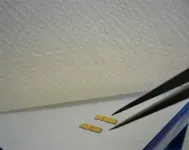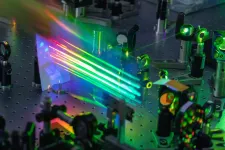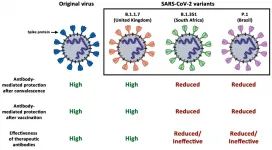TPU scientists develop sensor with nanopores for definition doping in blood
2021-03-25
(Press-News.org) Scientists of Tomsk Polytechnic University jointly with colleagues from different countries have developed a new sensor with two layers of nanopores. In the conducted experiments, this sensor showed its efficiency as a sensor for one of the doping substances from chiral molecules. The research findings are published in Biosensors and Bioelectronics (IF: 10,257; Q1) academic journal.
The material is a thick wafer with pores of 20-30 nm in diameter. The scientists grew a layer of metal-organic frameworks (MOF) from Zn ions and organic molecules on these thick wafers. The MOF has about 3 nm nanopores only. It plays the role of a trap for molecules, which must be detected.
"This sensor can operate with chiral molecules. Such substances consisting of chiral molecules are a lot among medical drugs and biologically active compounds. Their feature lies in consisting of a couple of enantiomers, which are actually identical molecules with identical structure and physical properties, however, they are mirror images of each other. Due to this difference, enantiomers can have various biological effect: one enantiomer can be effective, while the second one will cause harm. The main challenge is that both enantiomers must be detected in a biological sample. Our research team specializes in creating chiral sensors, operating on the effect of surface plasmon resonance. We have already had a wide range of interesting efficient material sensors in this field, however, we offered absolutely a new structure in this research work," Pavel Postnikov, Associate Professor of the TPU Research School of Chemistry and Applied Biomedical Sciences, says.
If the light (for instance, a laser ray) is directed on this material, the effect of surface plasmon resonance occurs on the gold porous film. The surface plasmon resonance is the origin of an analytic signal that can be sensed by a portable surface-enhanced Raman spectroscopy (SERS) sensor. Due to the signal, it is possible to define, what a substance is captured by the MOF and in what volume. The overall analysis procedure takes less than 5 minutes.
"What did the obtained structure give to us? First, at the same time, we obtained two plasmonic effects: the surface plasmonic effect, as it occurs on the film surface and the localized surface plasmonic effect in pores. Using the other structure, such synergy cannot be achieved. Second, pores serve us as a filter twice and allow us to separate the required substance from other blood components, which can block the sensor," Olga Guselnikova, Research Fellow of the TPU School of Chemistry and Applied Biomedical Sciences, the author of the article, says.
The researchers tested the sensitivity of sensors not only on model solutions but also on blood plasma and serum, in which the doping substance was added. In the conducted experiments, two sensors were used: each was responsible for the definition of a particular enantiomer of this substance.
"Standard methods for the definition of chiral compounds, for instance, chromatography, are expensive and require complicated equipment and special skills to use it. Our sensors are suitable for portable SERS sensors, which are considerably cheaper and simpler in use," Olga Guselnikova notes.
INFORMATION:
The scientists from the University of Chemistry and Technology, Prague, the University of Queensland (Australia), Korea Electronics Technology Institute and Korea Institute of Industrial Technology, National Institute for Materials Science (Japan) took part in the research work. The research is supported by a grant from the TPU Competitiveness Enhancement Program.
[Attachments] See images for this press release:

ELSE PRESS RELEASES FROM THIS DATE:
2021-03-25
In the future, photovoltaic cells could be "worn" over clothes, placed on cars or even on beach umbrellas. These are just some of the possible developments from a study published in Nature Communications by researchers at the Physics Department of the Politecnico di Milano, working with colleagues at the University of Erlangen-Nuremberg and Imperial College London.
The research includes among its authors the Institute of Photonics and Nanotechnology (IFN-CNR) researcher Franco V. A. Camargo and Professor Giulio Cerullo. It focused on photovoltaic cells made using flexible organic technology. Today's most popular photovoltaic cells, based on silicone technology, are rigid and ...
2021-03-25
The Miscanthus genus of grasses, commonly used to add movement and texture to gardens, could quickly become the first choice for biofuel production. A new study shows these grasses can be grown in lower agricultural grade conditions - such as marginal land - due to their remarkable resilience and photosynthetic capacity at low temperatures.
Miscanthus is a promising biofuel thanks to its high biomass yield and low input requirements, which means it can adapt to a wide range of climate zones and land types. It is seen as a viable commercial option for farmers but yields ...
2021-03-25
Energy models are used to explore different options for the development of energy systems in virtual "laboratories". Scientists have been using energy models to provide policy advice for years. As a new study shows, energy models influence policymaking around the energy transition. Similarly, policymakers influence the work of modellers. Greater transparency is needed to ensure that political considerations do not set the agenda for future research or determine its findings, the researchers demand.
Renewable energies bring many changes, including fluctuations in the energy supply and a more geographically distributed generation system. ...
2021-03-25
A collaborative research project by team of undergraduate students from the University of Exeter's Natural Sciences department has been published in a prestigious academic journal.
Lewis Howell, Eleanor Osborne and Alice Franklin have had their second-year research published in The Journal of Physical Chemistry B.
Their paper, Pattern Recognition of Chemical Waves: Finding the Activation Energy of the Autocatalytic Step in the Belousov-Zhabotinsky Reaction, was a result of their extended experiment work in the Stage 2 module "Frontiers in Science 2".
Their project involved the Belousov-Zhabotinsky chemical reaction - an ...
2021-03-25
March 7, 2021, KAUST, Saudi Arabia - KAUST Assistant Professor of Computer Science Mohamed Elhoseiny has developed, in collaboration with Stanford University, CA, and École Polytechnique (LIX), France, a large-scale dataset to train AI to reproduce human emotions when presented with artwork.
The resulting paper, "ArtEmis: Affective Language for Visual Art," will be presented at the Conference on Computer Vision and Pattern Recognition (CVPR), the premier annual computer science conference, which will be held June 19-25, 2021.
Described as the "Affective Language for Visual Art," ArtEmis's user interface has seven emotional descriptions on average for each image, bringing the total count to over 439K emotional-explained attributions from humans on ...
2021-03-25
While urban agriculture can play a role in supporting food supply chains for many major American cities -- contributing to food diversity, sustainability and localizing food systems -- it is unrealistic to expect rooftop gardens, community plots and the like to provide the majority of nutrition for the population of a metropolis.
That's the conclusion of a team of researchers who analyzed the nutritional needs of the population of Chicago and calculated how much food could be produced in the city by maximizing urban agriculture, and how much crop land would be needed adjacent to the city to grow the rest. The study was the first to evaluate land required to meet ...
2021-03-25
Scientists have shown that SARS-CoV-2, the virus that causes COVID-19, can infect specific cells in the salivary gland in the mouth. The study by researchers from the Wellcome Sanger Institute, National Institutes of Health and the University of North Carolina at Chapel Hill, and their collaborators within the Human Cell Atlas Oral & Craniofacial Network, also discovered that live cells from the mouth were found in saliva, and that the virus was able to reproduce within these infected cells.
The study revealed that salivary gland cells could play a role in transmission ...
2021-03-25
Göttingen, March 25, 2021. Testing and vaccination - these are the pillars on which humanity is trying to get a grip on the Coronavirus pandemic. Although it is taking longer than many had expected, it is believed that it is only a matter of time before we are all vaccinated and thus protected. However, time is also working for the virus, which has now mutated several times, with variants B.1.1.7 from the United Kingdom, B.1.351 from South Africa and P.1 from Brazil spreading rapidly. These viruses have mutations in the so-called spike protein, the structure on the surface of the virus that is responsible for attachment to host cells. At the same time, the spike protein is also the major target of the immune response. Antibodies generated in response to SARS-CoV-2 infection or vaccination ...
2021-03-25
Supersized alcopops are ready-to-drink flavored alcoholic beverages with high alcohol content that are disproportionately consumed by underage drinkers. There can be up to 5.5 standard alcoholic drinks in a single 24 ounce can, so consuming only one can of supersized alcopop is considered binge drinking, and consuming two cans can cause alcohol poisoning. Still, these products remain under-regulated and are available inexpensively at gas stations and convenience stores, where they are more readily accessible by underage youth.
New research led by George Mason University's College of Health and Human Services found that nearly ...
2021-03-25
The burial field in Valsgärde outside Uppsala in central Sweden contains more than 90 graves from the Iron Age.
"On a light note, we could say that Valsgärde is Scandinavia's answer to Sutton Hoo in England as portrayed in the film The Dig on Netflix," says Birgitta Berglund, professor emeritus of archaeology at the Norwegian University of Science and Technology's NTNU University Museum.
Valsgärde is especially known for its spectacular boat graves from the 600s and 700s CE. This timeframe is in the middle of what Norway calls the Merovingian period, the era just before the Viking Age.
Two of these spectacular boat graves are at the centre of this story -- or more specifically, the story is really about the down bedding that was found ...
LAST 30 PRESS RELEASES:
[Press-News.org] TPU scientists develop sensor with nanopores for definition doping in blood




